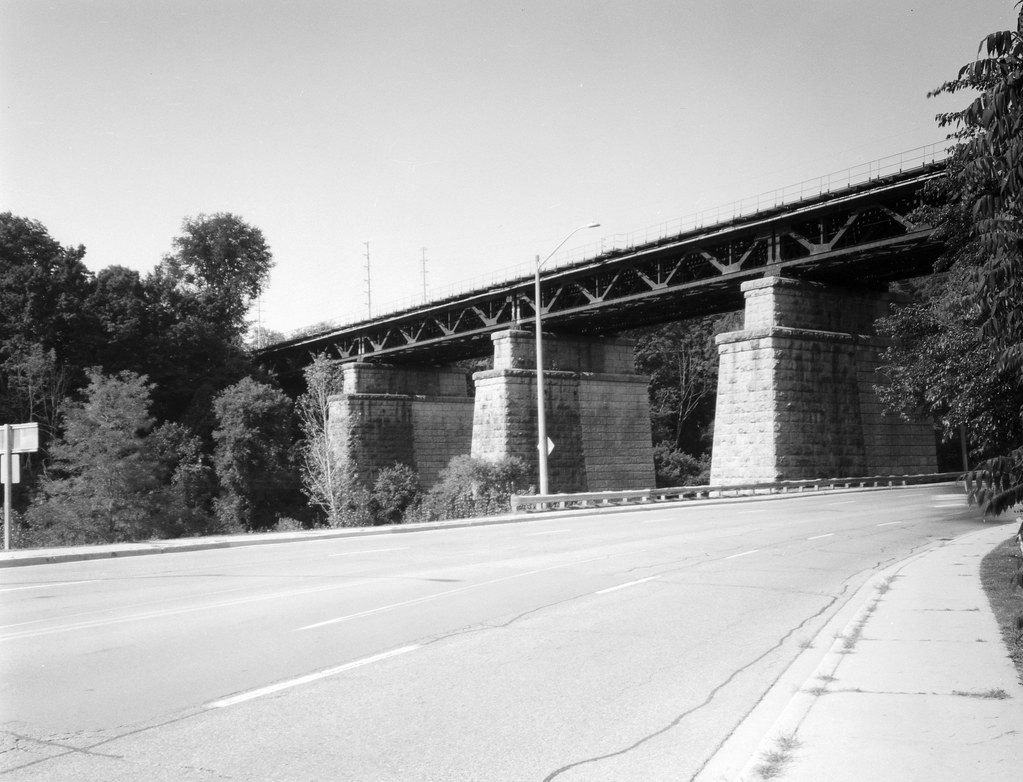Last year I completed a project about Ontario’s railway heritage. Still, one location I had sadly missed was Oakville, as there is no historic railway station in the community, as both Oakville and Bronte had been replaced in the 20th century. But this massive railway viaduct over the Sixteen Mile Creek caught my eye, not only because I’ve travelled over it many times, but because it looked old.

The railway was both a boost and a problem for the growing community of Oakville by the mid-century. The railway would open up a faster means of moving both people, mostly goods, across the province. And a community that got access to a major railway line would instantly boost the local economy. But the railway operators of the 19th century were powers unto themselves, had the government on their side and would run the lines as they saw fit. Oakville’s railway line was part of the Hamilton & Toronto Railway Company, chartered in 1852; the company’s primary stakeholder was the Great Western Railway. While Great Western’s main line would run from Niagara Falls to Sarnia, a branch line to Toronto made sense for passenger and cargo traffic. The Toronto to Hamilton line ran north of the communities of Bronte and Oakville in the Trafalgar township and boosted both, making them the two largest settlements in the township. The Sixteen Mile Creek presented a major topographical issue to the railway operator. Still, a single-track bridge supported by tall stone piers was erected in 1854, in time for the first train to roll through in 1855. A simple shed-type station was built to provide for those using the railway. After a deadly accident, the rails were upgraded from iron to steel to prevent future accidents. Great Western would also begin adding a second track to their lines in 1878, a task that would fall to Grand Trunk when they acquired the entire company in 1882. Grand Trunk also completed a modernisation program starting in 1896 that probably saw the decking of the creek bridge updated along with the rails and a new Queen Anne Style station built to replace the ageing GWR station. By this point, the Hamilton to Toronto line saw GTR trains and those operated by Canadian Pacific, New York Central and Toronto, Hamilton & Buffalo. Canadian National took over operations in 1923, following a messy bankruptcy of Grand Trunk, and the Oakville line and bridge formed a part of CNR’s mainline across southern Ontario. The old GTR station was replaced in the 1950s with the current modern structure, which has also seen its share of updates over the years. GO Transit began operating along the line in 1967, and VIA rail took over passenger services in 1974. This increase in rail traffic meant that a third rail would be added, and the bridge was again updated by extending the stone piers, a project that saw completion in the early 21st century. And today, the historic bridge, with its matching but separate piers, continues to operate rail traffic across Oakville.
Photographing railway infrastructure presents many different issues. While stations are easily captured, bridges can prove challenging as the wrong person might photograph an active bridge the wrong way. It also doesn’t help that some bridges don’t have clear sight lines. Thankfully the Sixteen Mile Creek bridge can be photographed if you know where to position yourself at the foot of Cross Avenue. I wanted to capture the two different piers and the decking itself. Using the 125mm and some front rise, I metered for the older sections of the piers and under-exposed by a stop. Yes, I lost all sky details, but the bridge was the main subject. Also, a bit of patience to wait for a gap in traffic. Despite having that road sign on the left as a distraction, I’m good with this image.